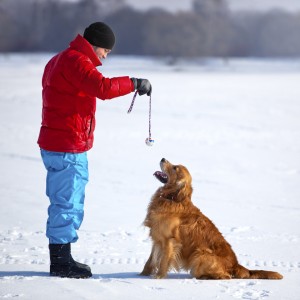 With NC temperatures slated to drop into single digits in the coming week, it’s essential for you to know what is reasonable for your pet to handle and what isn’t.
With NC temperatures slated to drop into single digits in the coming week, it’s essential for you to know what is reasonable for your pet to handle and what isn’t.
These cold weather pet safety tips from the American Veterinary Medical Association (AVMA) will help you keep your furbaby warm and snug indoors and out, regardless of what the weather decides to throw at us.
Get a Wellness Check
If your pet is going to spend significant amounts of time out in the cold, it’s best to get a preventive care or wellness examination ahead of time. This will help you to know if he or she has any medical conditions that could be worsened by the chill. Arthritis, for example, can become painful and inflamed through exposure to weather.
Healthy senior pets and puppies could also have lower tolerance for cold temperatures, as do animals suffering from chronic conditions such as diabetes, heart or kidney disease. Pets with hormonal imbalances, such as Cushing’s, struggle to regular their body temperature, which makes them more vulnerable to problems when it’s cold.
Provide Sleeping Options
You aren’t the only one who enjoys the creature comforts associated with being in a warm, snug bed! Just because your dog or cat insisted on sleeping on the cold tiled floor during summer doesn’t mean he or she is still going to be comfortable there now. Give your pet some safe options for sleeping to choose from until you know which your dog or cat prefers.
Make sure the bed is out of the way of any chilly drafts. If the floor beneath the bed is cold, put a rug or a layer of newspaper or cardboard in between. Don’t position the bed too close to the heating source or your pet might find it too warm and end up back on the cold, hard floor!
Be Clever About Coats and Clothing
Even a young, healthy animal will feel the chill if his coat is too short to keep him warm. Long-haired pets aren’t immune either, however, because if their coats get wet and freeze, their body temperature is sapped very quickly. A warm, dry sweater or raincoat will protect your dog from the elements during your daily walk, and if you get a snowfall you might find booties will help prevent both “frozen foot” and cuts from salted sidewalks. If your dog won’t agree to footwear, make it a point to wipe down or wash his feet, legs and belly after walks to remove de-icers, antifreeze and any other poisonous substances he might pick up outdoors. Finally, remember that a warm coat won’t protect your pet if left in a cold car for any length of time, and if your pet is wearing any clothing that gets wet, you need to get it off quickly.
Outdoor Activities
When you’re out walking with your dog, avoid lakes and waterways and areas where you find water or ice. Don’t allow her to run on frozen patches of ground, as a single slip can result in a broken bone or a torn ligament. Never leave a dog or cat outdoors for longer than necessary unless you have a properly-equipped, warm shelter with a doorway that faces away from the wind.
Car Concerns
When you’re ready to leave home, check that you have no campers in your car before starting out. Feral cats and other small animals often climb into car engines or settle under cars for warmth and shelter. Bang on the hood or honk your horn to wake them, and if you hear any sounds check the engine before you drive away.
Another car concern is access to anti-freeze, which has a sweet taste that attracts animals but is very toxic if ingested. Keep it locked away, and if you do happen to spill some, clean it up thoroughly right away to avoid pets or other animals getting into it.
Watch for Problems
The most important aspect of cold weather pet safety is to watch your pet and take action if he or she starts showing any signs of distress. Whining or shivering, seeming to be nervous or weak, slowing down or stopping moving while outdoors could be the first symptoms of hypothermia. By the time you see actual signs of frostbite it can be far worse than seems, so get him to your veterinarian as soon as you see indications of unusual behavior.

